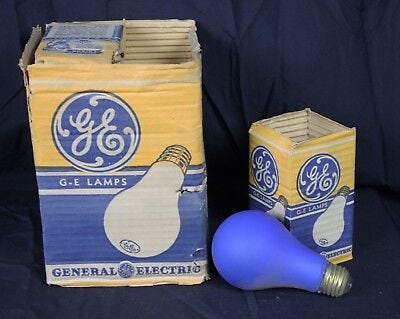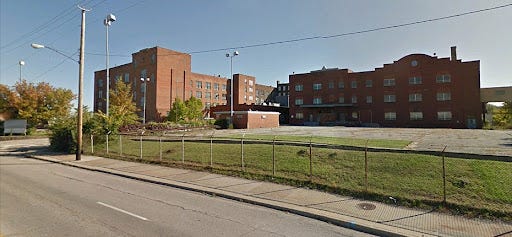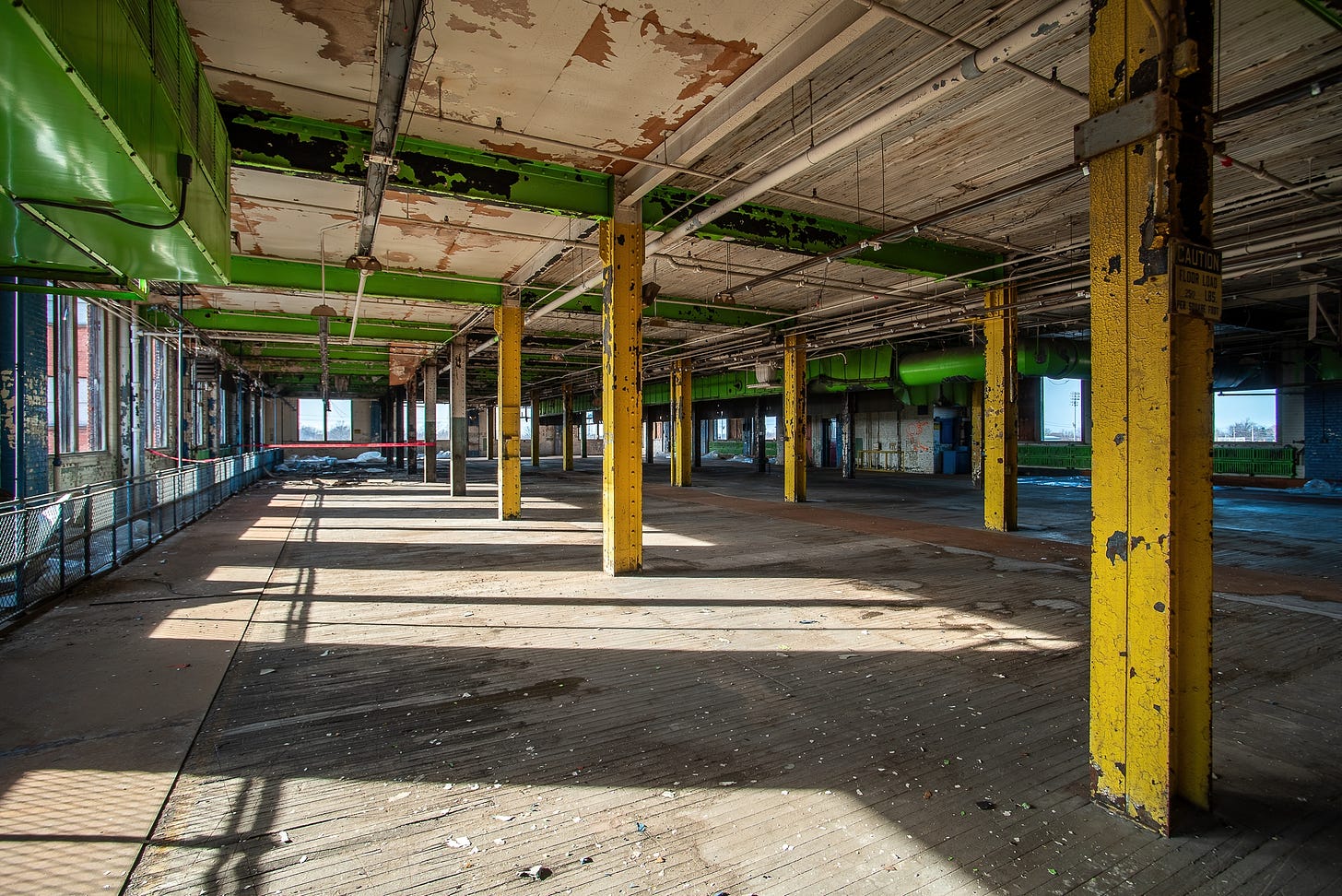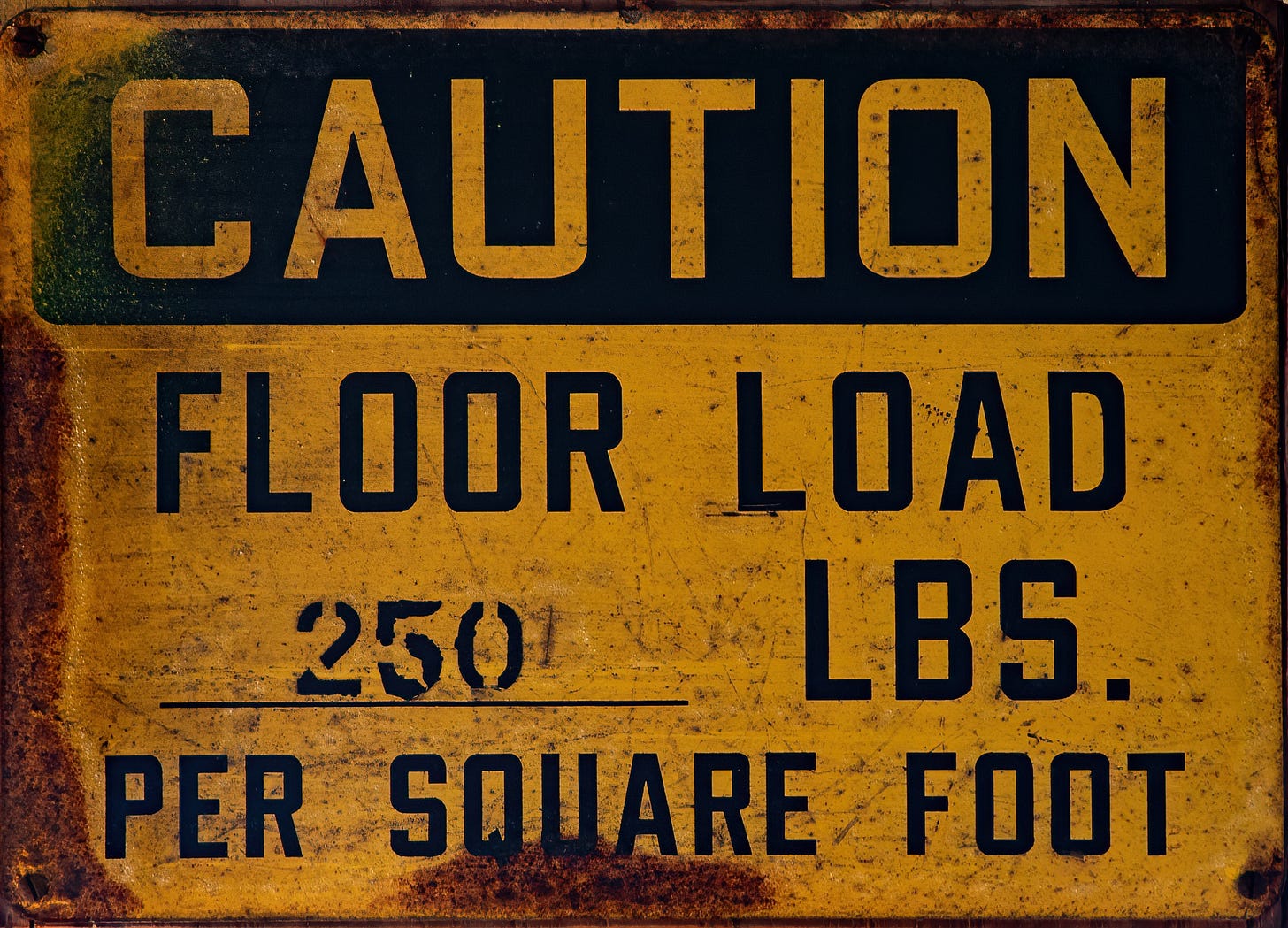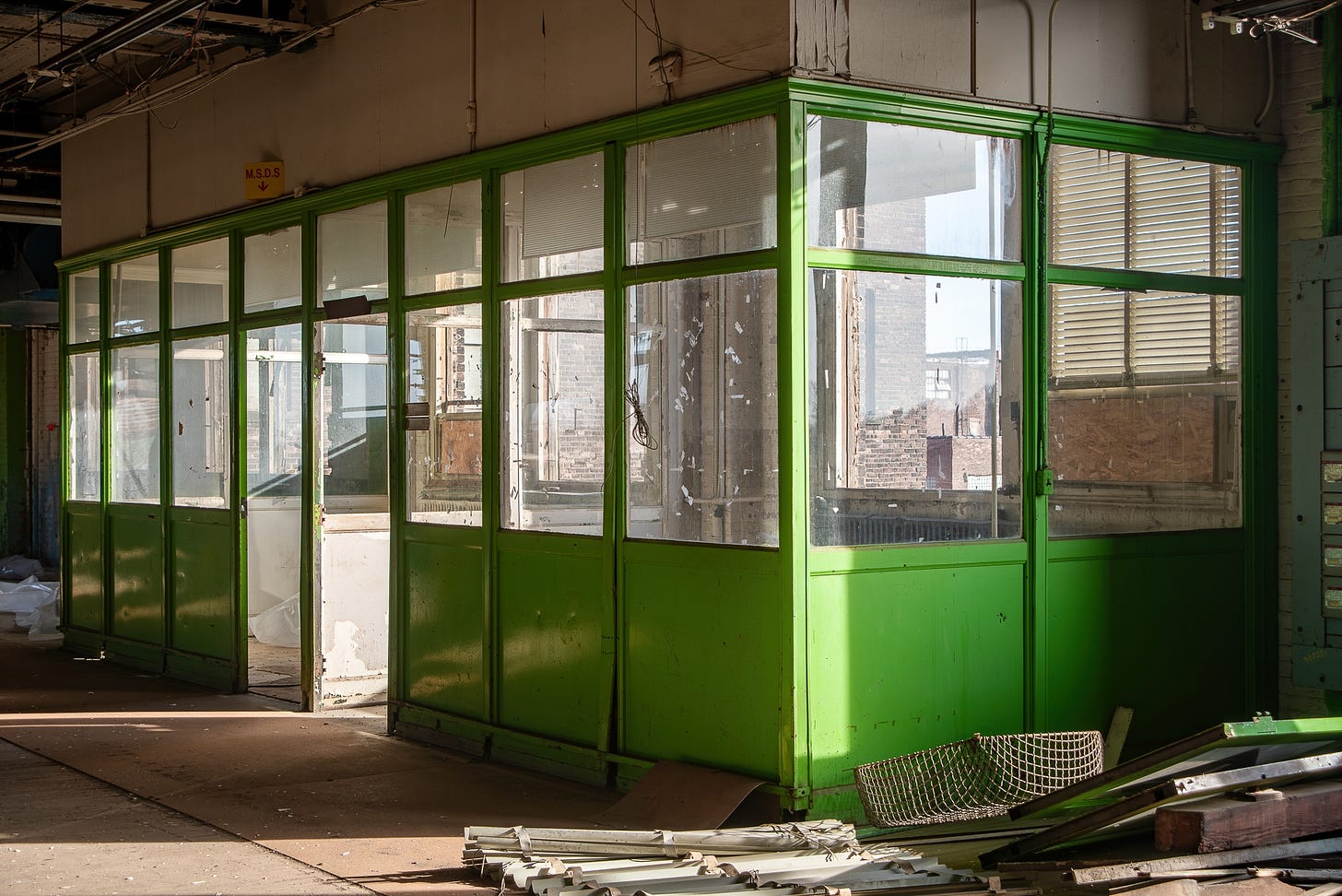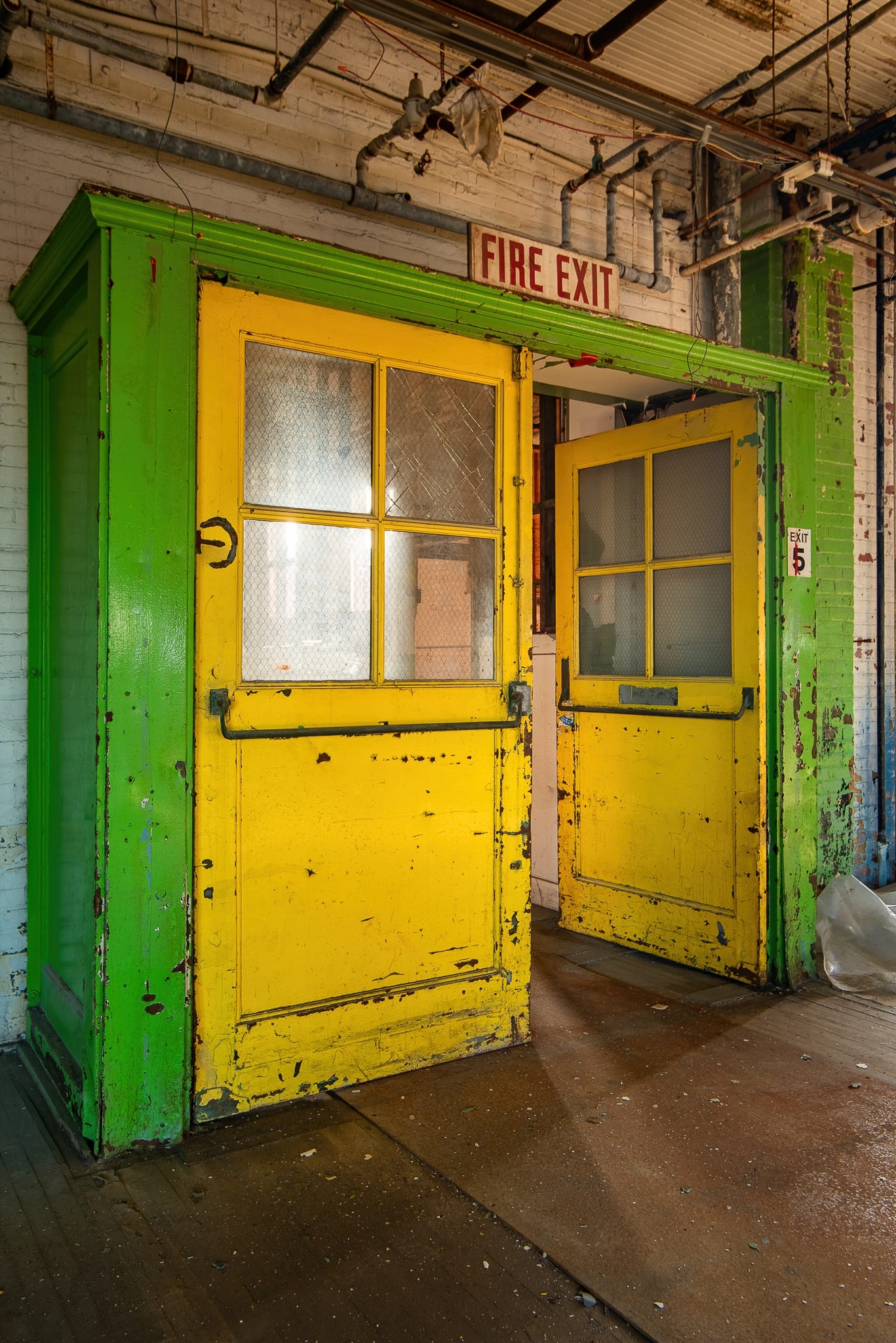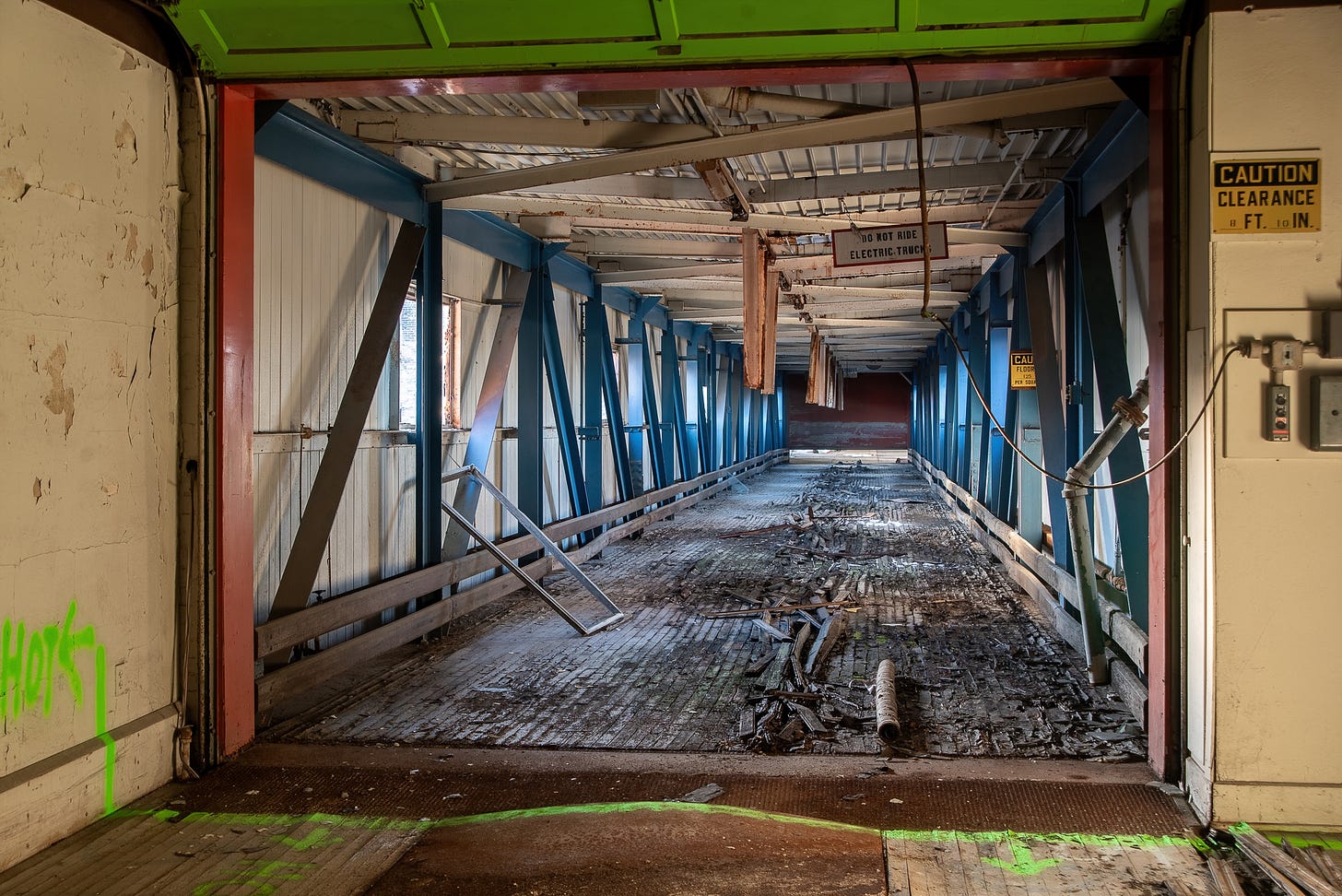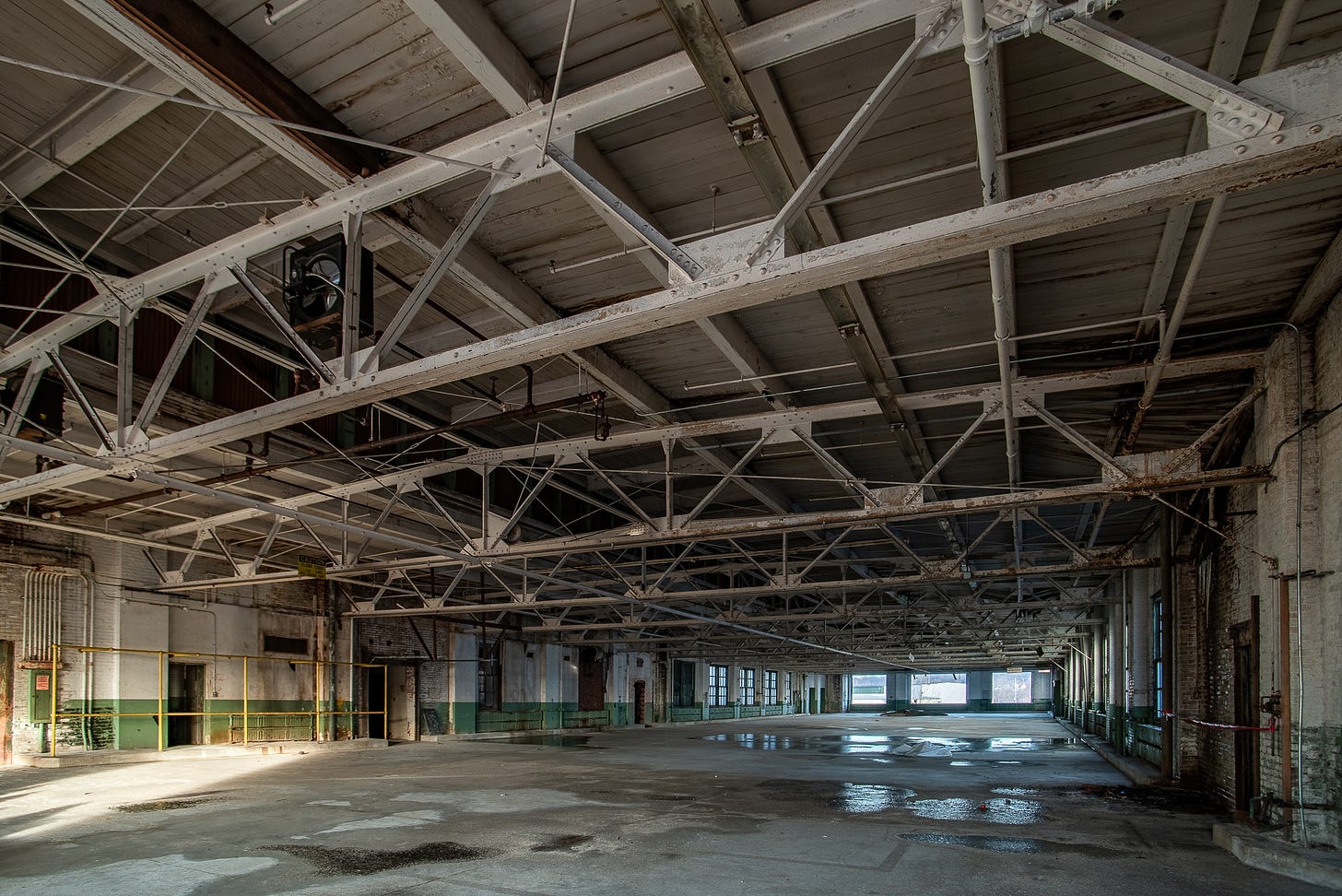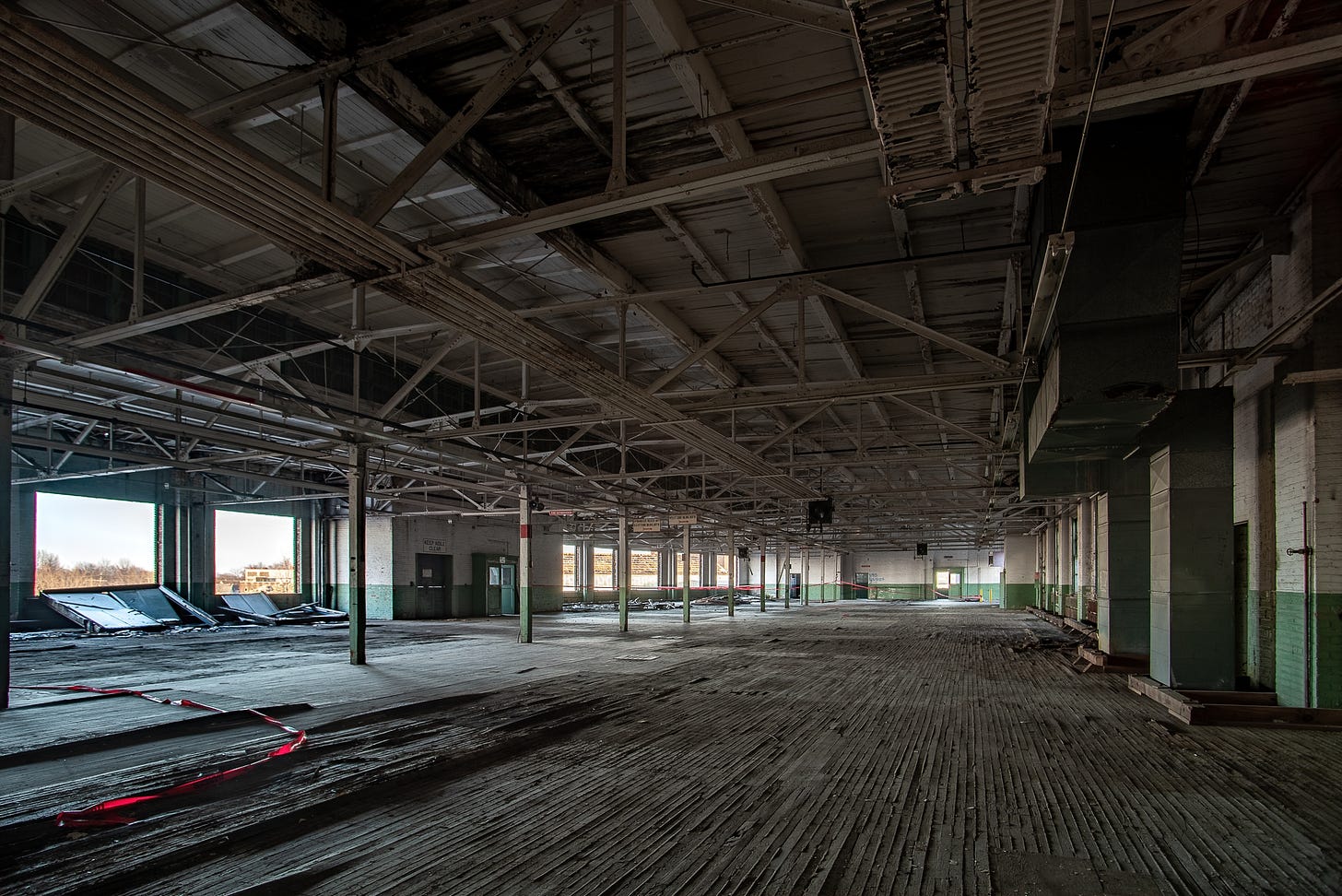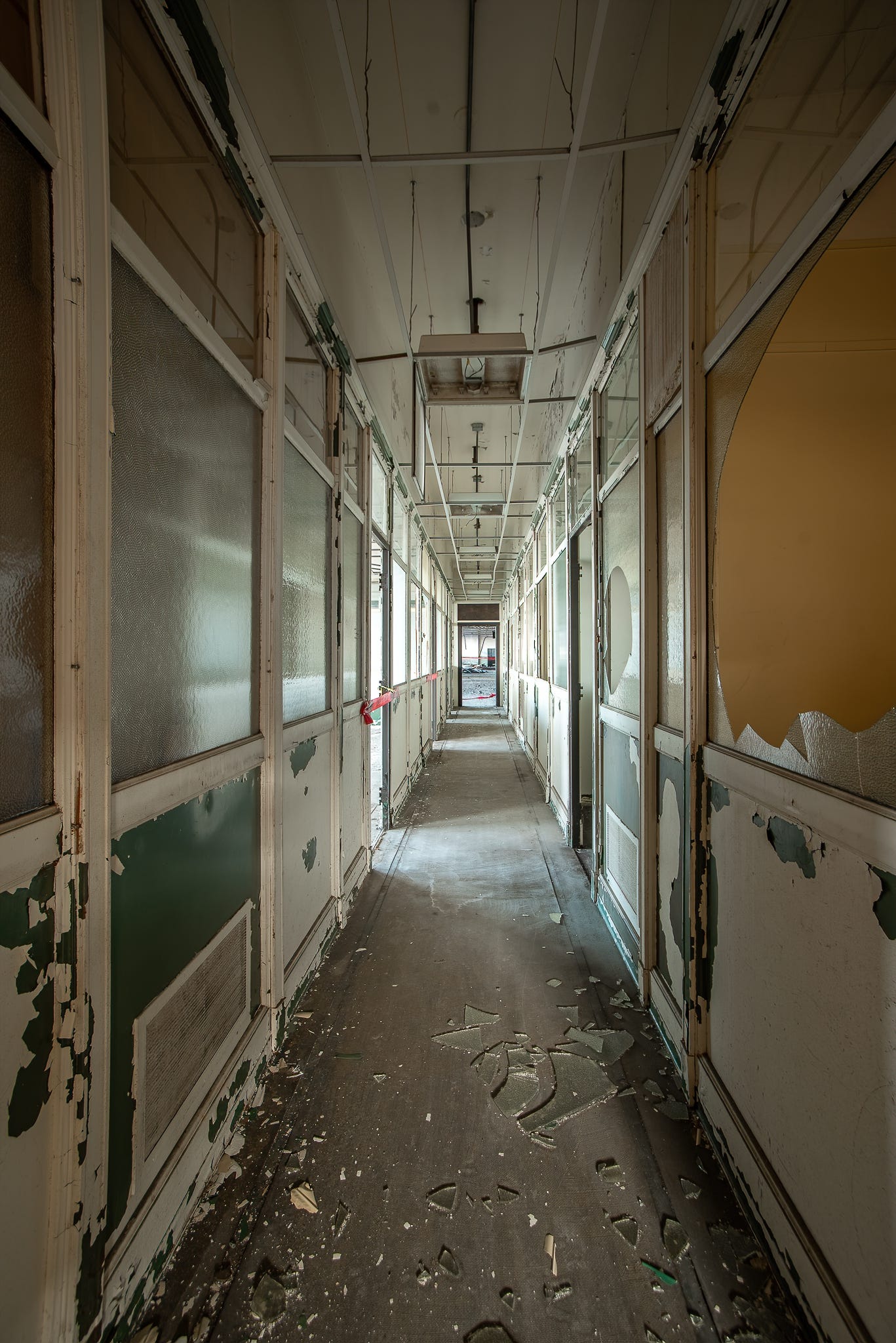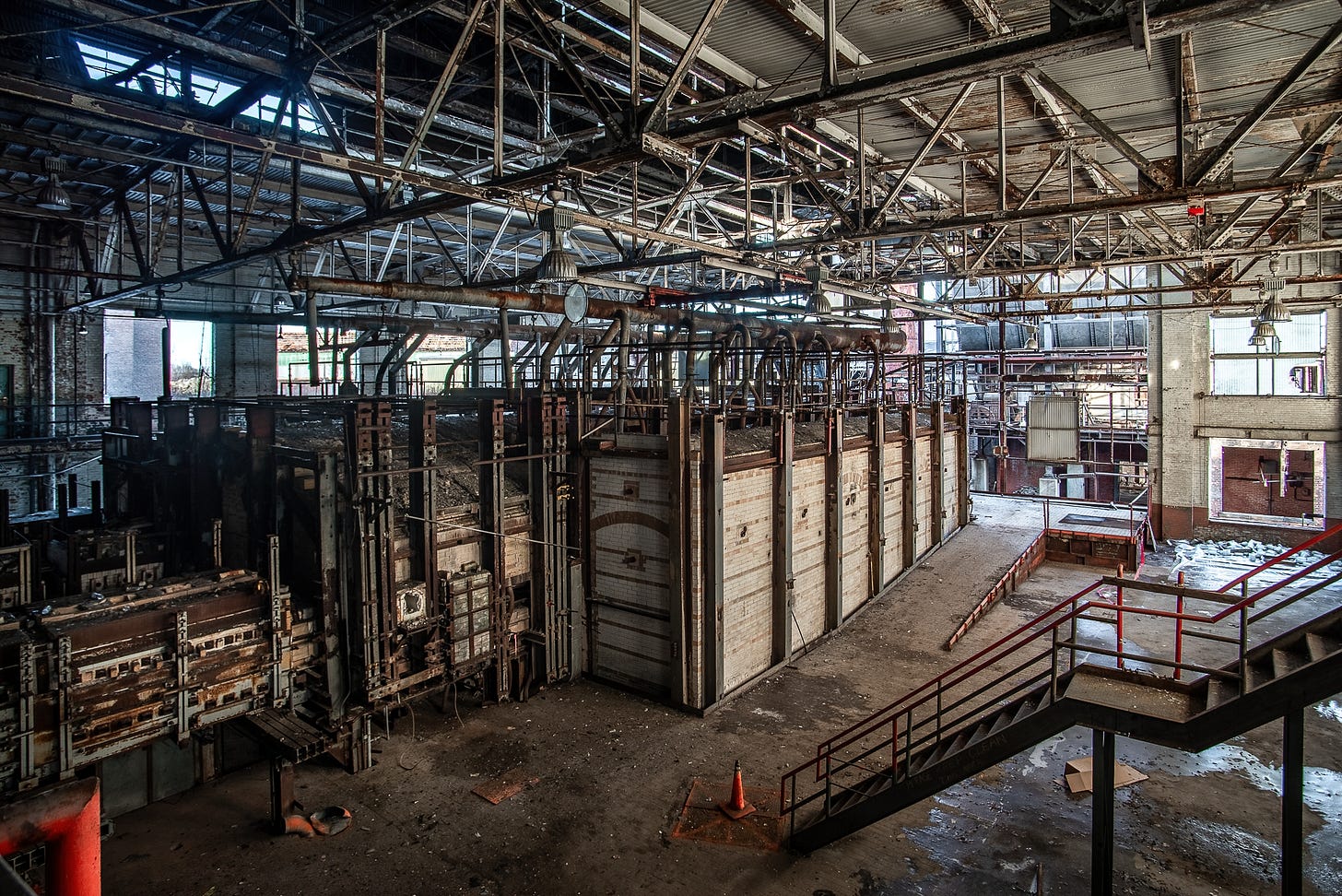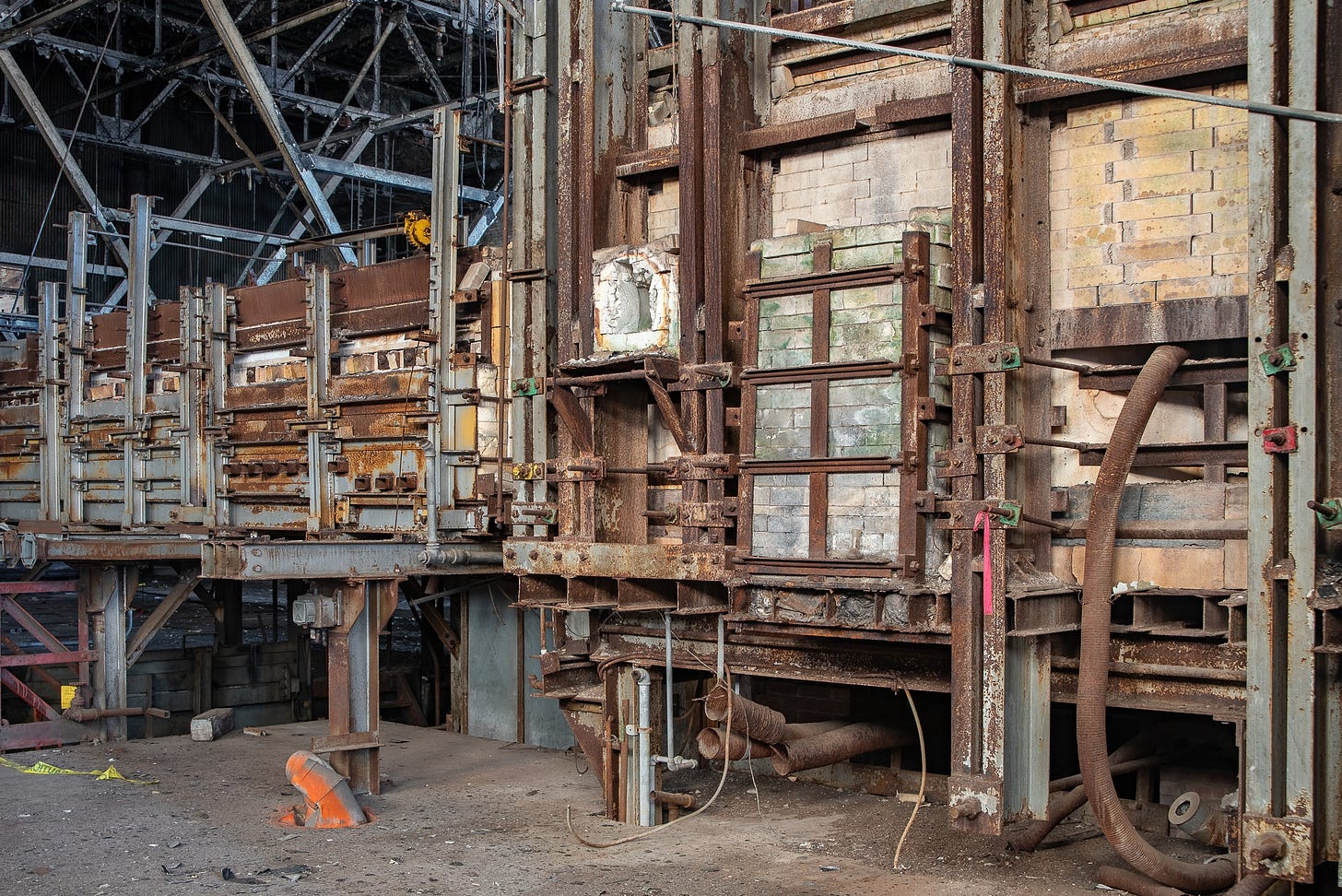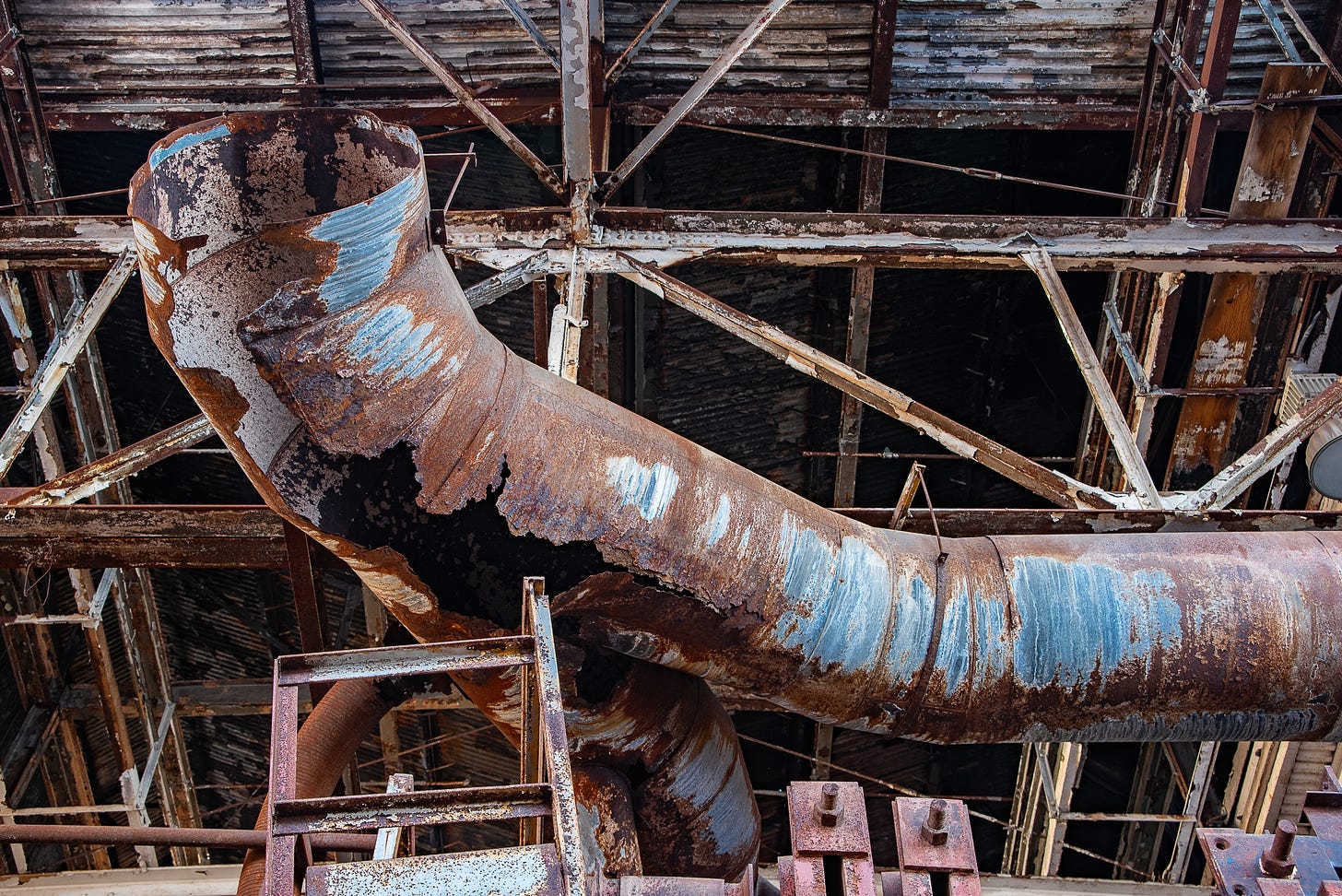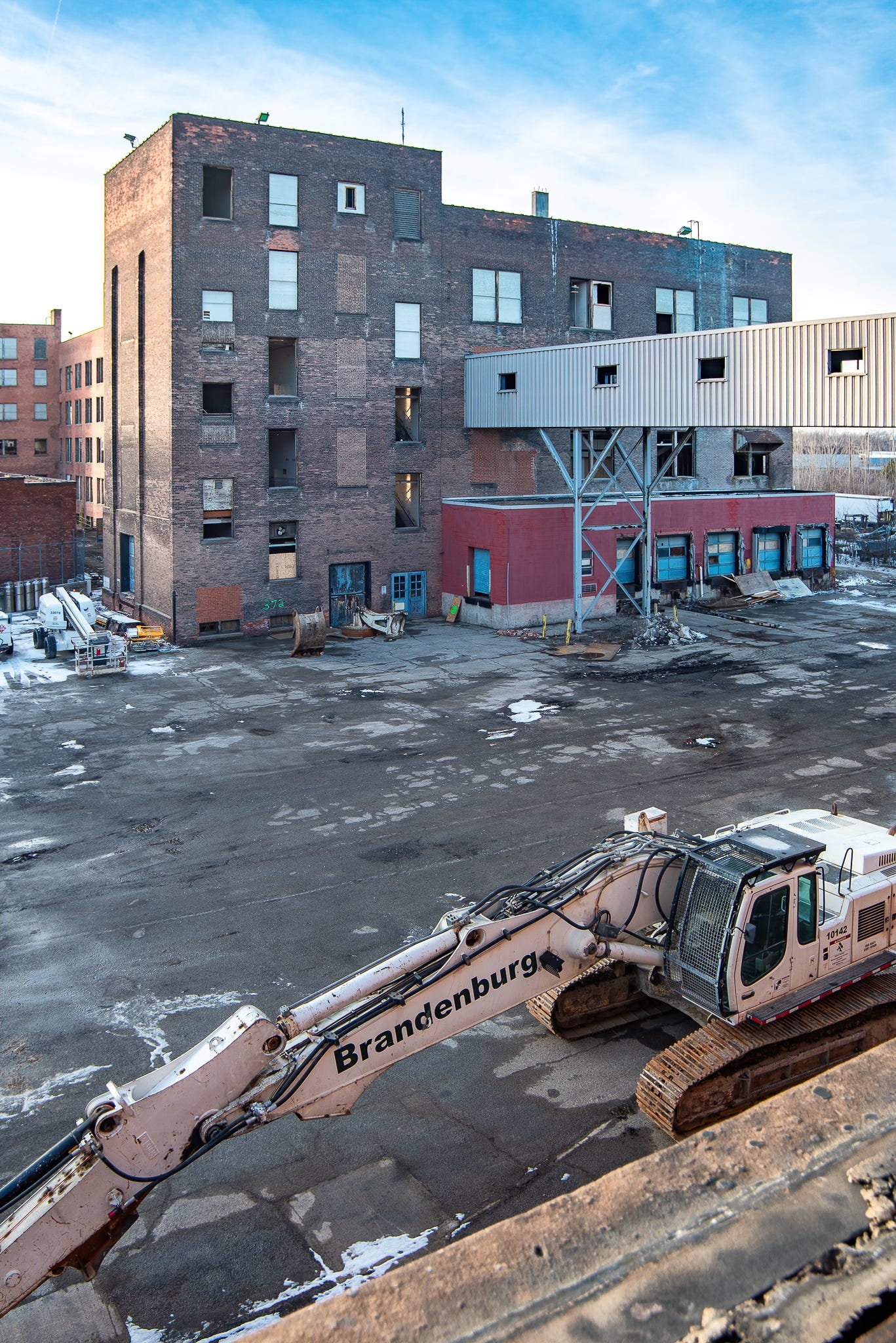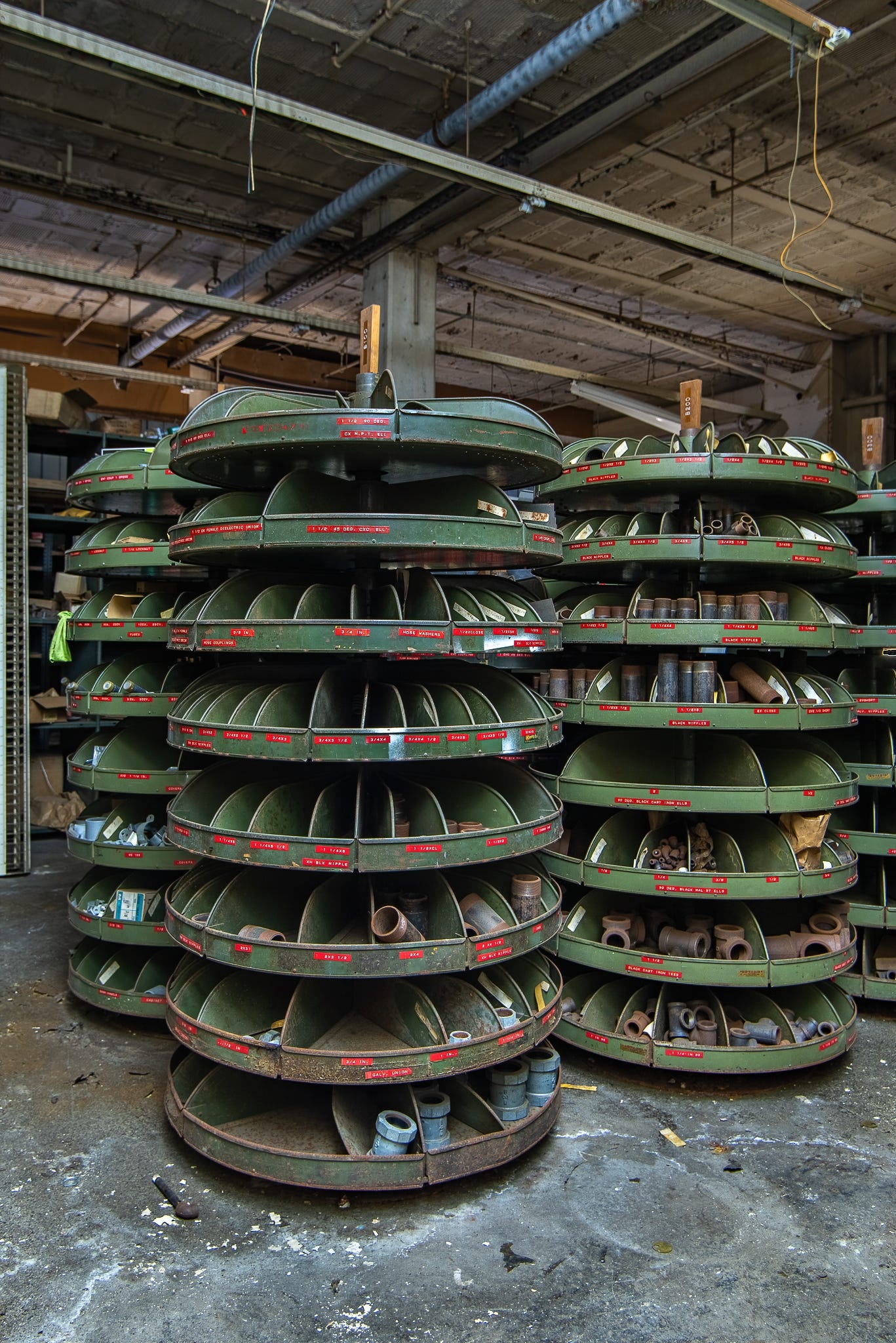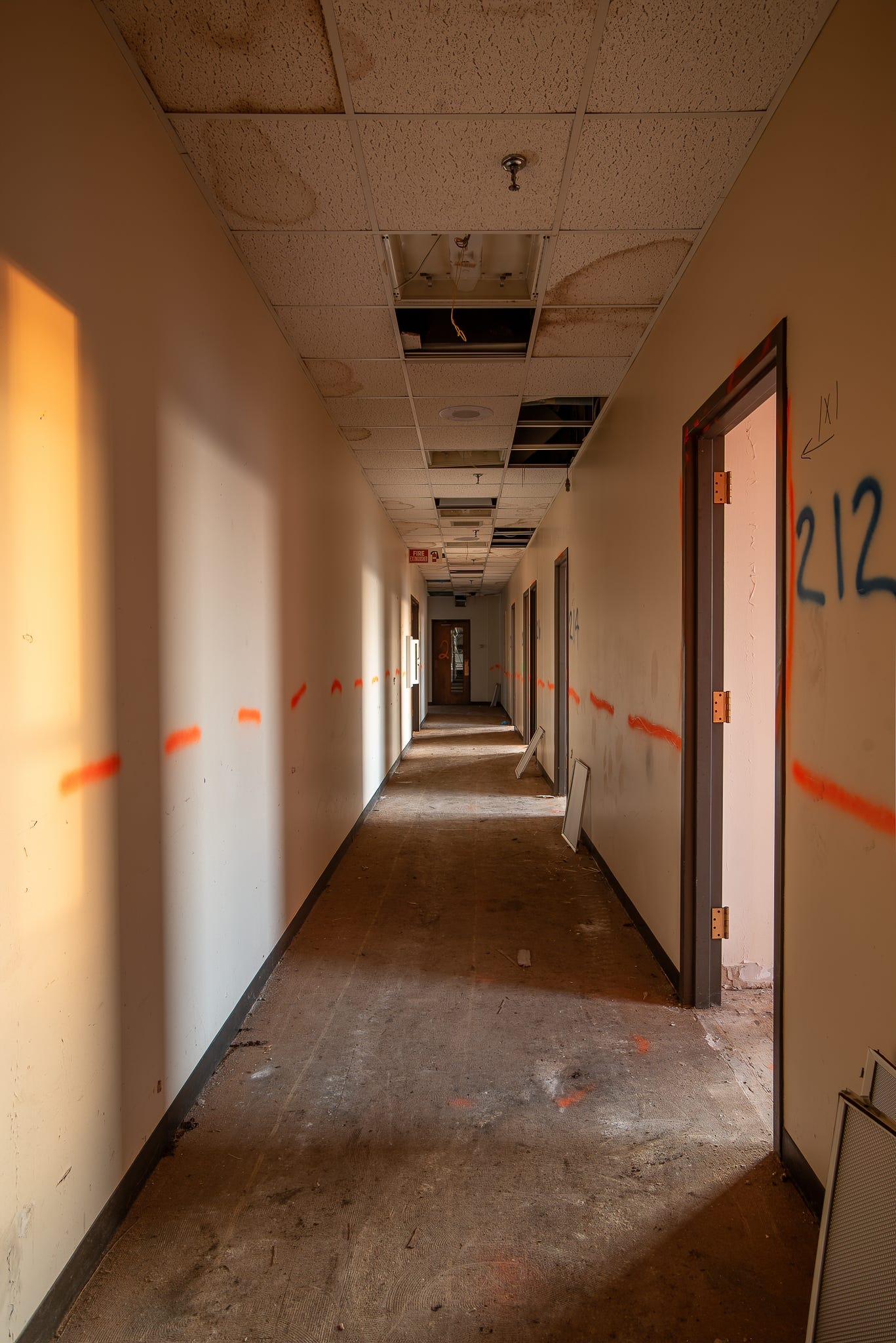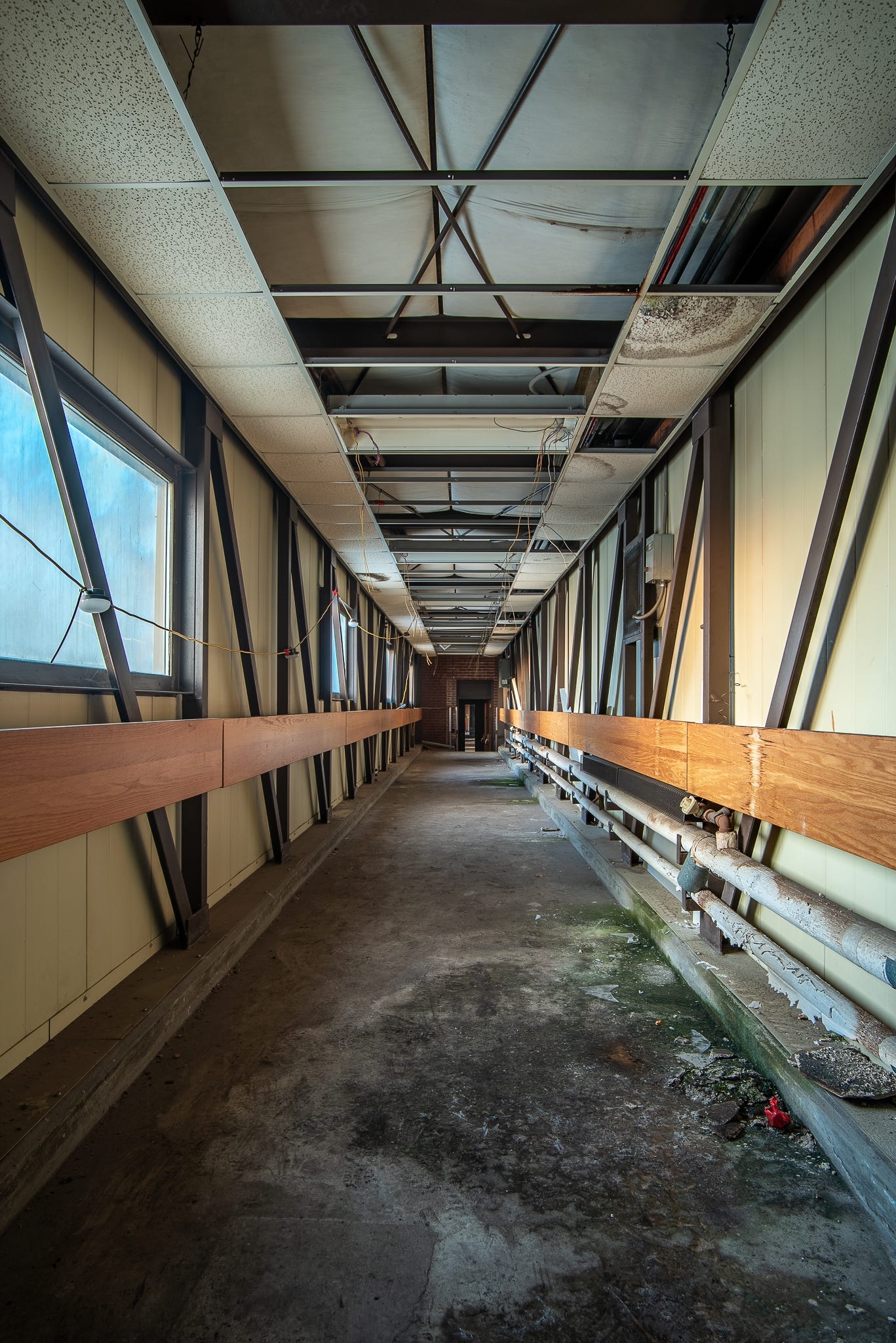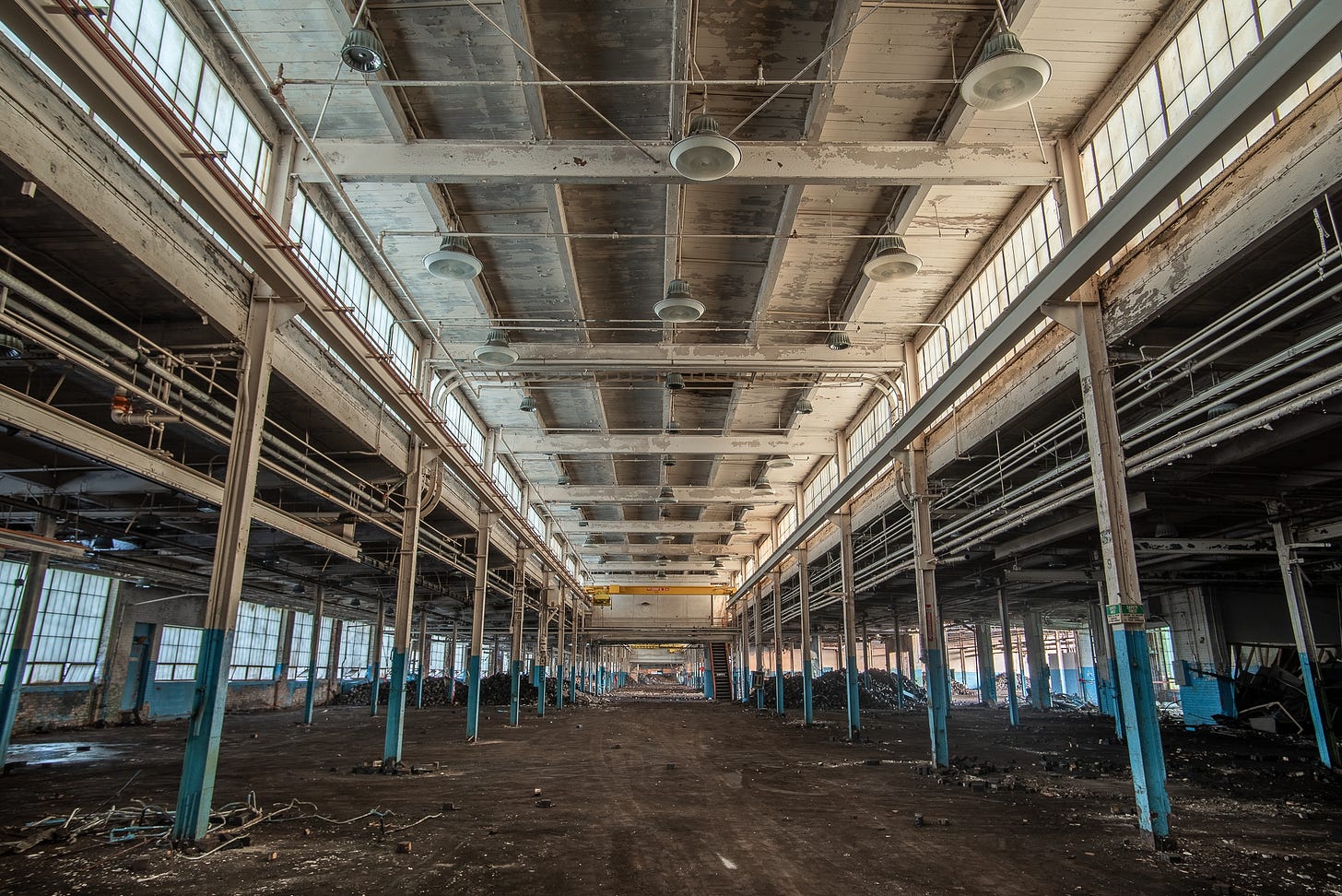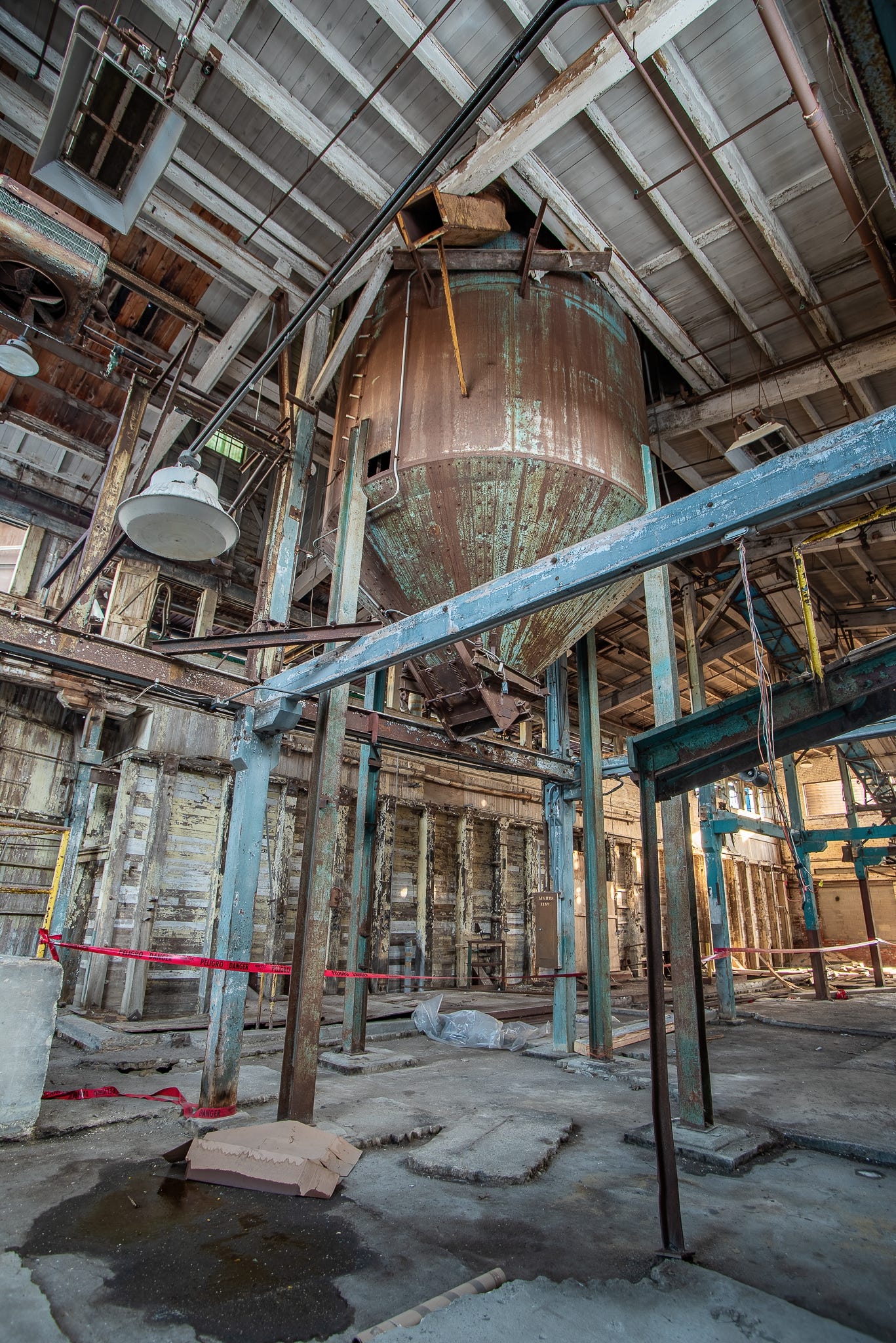Obscuratio Lucis: The Demise of East Cleveland's General Electric Plant
Once a massive plant owned by General Electric, doomed to demolition...
It's often the case that when you go out for an afternoon of exploring, you’ve planned out your itinerary, or at least have a good idea of what you plan to do, where to park and what your strategy is going to be, especially if you find yourself in a distant city or locale. Hours of poring over Google Maps, researching local areas, finding places to hide your car out of the eyesight of those pesky and nosy locals so as to avoid any unpleasant entanglements with insane private property crusader neighbors with shotguns, wandering opportunist crackheads, local neighborhood ruffians, cranky urban cops, or worse, rural constabulary. Planning is everything. The more you plan, the better your chances of a successful exploration, under most circumstances. But sometimes, things just fall into your lap when you least expect it. Wondrous things drop into your sights when you are totally not looking for them, and sometimes they make whatever else you had planned for the day completely ignorable. When that kind of thing goes down, all plans go down the toilet, and you take advantage of the gift the urban exploration gods have bestowed upon you. It doesn’t happen often, but when it does, it usually happens big.
The topic of today’s exploratory miracle was right here in Cleveland. East Cleveland, to be exact, and to this day, I still don’t know how we never got the idea to go out and take a look at the place sooner, since it closed down in 2011. That place was the former and absolutely massive General Electric complex that once employed hundreds in that area of town, but which had been boarded up for years, sitting there right under our noses. And as it turns out, we found it none too soon, as it was just beginning to undergo abatement for demolition. As in, they had just popped her open and had begun surveying her and ripping out machinery and asbestos. Not too much work had been done yet, but equipment was being brought in and markings were being made inside. Everything was as it had been for years, with no changes; decaying and dusty. Virgin territory. We got there at JUST the right time. But more on that later. Before we dive into this little adventure, let me lay down a little history for you on this mammoth place, which was a huge facility for the Cleveland area in the 20th Century.
G.E.: “We Bring Good Things to Life.”
This sprawling campus of electrical wizardry once stood at East 152nd and Noble Road in East Cleveland, and up until very recently, was a prominent feature on the landscape. Many of the front offices and facades had that institutional late 1940’s/early 1950’s look to them; multiple story brick boxes with the evenly spaced windows adorning each. The place was not a single factory, but a sprawling industrial estate made up of numerous individual and discrete factories. Their one common feature was that they were all involved in producing component parts and pre-materials for supply to other final assembly lamp plants. The main site was founded in 1913, and over time included Cleveland Bulb Works, Cleveland Weld Works, Cleveland Equipment Works, Euclid Glass Works, Pitney Glass Works, New Pitney Glass Works. These different factories and labs researched and manufactured welded lead wire assemblies, formed metal parts, glass tubing & bulbs, bulb finishing, quartz products, ceramics, lampmaking and glassmaking machinery. Later on, GE also bought the Abbot Motors Company to the south along Noble Road and retooled it for their needs. This place was at the head of GE’s research and development for decades, and based on some of the employee statements I was able to uncover in my research, the plant hallways felt like crowded high-school cafeterias, full of men who'd signed up for a lifetime of healthy wages and good benefits, just like their friends at GM or Ford. As recently as the mid-'90s, GE was still hiring people to make the ceramic innards of bulbs used to light highways.
Vintage General Electric Lightbulbs
By the 1990’s, General Electric's US Lamp Component manufacturing operations were hit hard following that company's 1990 takeover of the formerly state-run Tungsram company of Hungary, which had a similar technique of integration in lamp component manufacturing but with considerably lower costs than GE's American facilities could attain. That spelled trouble for GE. By the early 2000’s, GE announced it would shut down six local factories, killing off 425 jobs. The work, as with so many other industries before it, went where most work goes these days, to places like China, Mexico and to Hungary, where GE’s new owners wanted to center everything. It was more than just a move for cheap labor. It was about going green. GE, like Ford or Chevy, didn't see the dollars to be made in trying to saving the planet until it was too late.
GE’s Cleveland facilities made mainly incandescent bulbs, the lights that have illuminated American homes for the last century, by the time of the closing. But thanks to a new federal energy-saving laws, more efficient compact fluorescent lamps (CFLs), spiral-shaped bulbs that resemble tiny white bedsprings, were being made. They cost 10 times the price of a regular bulb, but they also last five to eight years and cut down on energy use. The most popular CFL is not easy to produce and very expensive. GE invented the damn things in the first place, back in the 1970s, thought it would be too expensive to mass-produce, and so it had shelved the idea. Sadly, the country with the cheapest labor and highest pollution rates WAS able to manufacture them cheaper than anyone in the US: China. So…boom.
The complex was finally closed in 2011, and the remaining workers were given an option to work at other GE facilities around the country, which some took advantage of. After that, the place was sealed up, the power was cut and the place was quietly forgotten about over the next ten years, just another abandoned property in a city already thick with abandoned factories, homes and businesses.
Photo of the shuttered facility in 2015 (lamptech.co.uk/)All this being laid out for you, we had driven past before, but were never sure if it was still alarmed and powered, so we sat on the location for several years, until finally an article was seen online, mentioning an imminent demolition. On a cold February Sunday in 2023, we decided, almost on a whim, to go and check things out, not figuring that we’d have much success. Climbing through and over collapsed parts of the perimeter fence from the neighboring brownfields, we found ourselves on former GE property, and upon coming to the first building along East 152nd Street, we were rewarded with a wide open door, chocked open by inspectors, most likely even the day before. There were portable lights, extension cords and various tools assembled outside the door, presumably belonging to the survey crews. The doorway led promisingly into an internal stairwell. With a look at one another and an unspoken agreement, we nimbly sashayed on in and ascended to the very top, as is our usual tactic; start high and work down, as it gives you the higher ground to notice if anyone unwanted shows up around the property without being seen.
As it was in the initial stages of abatement, so much of the original factory was still intact. Most of the heavy machinery, the expensive stuff such as the assembly lines and the like, had been removed and sold off by GE years ago, but it still left pieces parts all over the top floor where we began our documentation. Two amazing things about this building; A) all of the old factory signage was still there. The 1950’s “Safety First” cartoon character type signs were everywhere, and some had been stacked up as abatement began. B) Everything, every beam, every wall, was painted in bright primary colors. Blues, yellows, greens, reds. This was NOT the typical color scheme for an older factory. It was downright cheerful, so maybe GE had the philosophy that bright colors would encourage workers to be happier in their work? No idea, but it was definitely different. Even the stairwell vestibules had this apple green and yellow color scheme.
Primary colors abound; not something one sees often in a factory…
Signage still hanging in the upper levels of the plant. There were many; a rarity in abandoned buildings.
Perhaps the old foreman’s office?
The building still had all of its original wooden flooring, and oddly, not much of it was decayed, despite broken windows open to the elements. Dusty perhaps, but you could have swept it and reopened for some other purpose the next day. That led us to believe that up until very recently, the windows had been fully intact that that the building had been very, very tightly sealed. This would explain how the wooden floors weren’t warped and how there was absolutely no tags or graffiti. The entire complex, most likely, had sat like this since it closed. We worked our way down and across each level, capturing the bright winter light coming through the few still intact windows, splashed across the floors. Between the light and the color, this has to have been one of the most cheerful abandoned buildings I’ve ever explored, and that made it all the sadder to know that it would all be gone in a few months.
The jolly colors of lead paint on this fire exit door on the third floor…
After the first building had been investigated (we had to move fast, and got in as much as we could, because we were racing against the clock before sundown), we re-ascended the stairs and investigated a third-floor skyway that attached that building to the massive industrial building to the east. To access it, we had to somehow unstick the garage doors that had been closed over the entrance to it. Naturally, we cringingly made as much noise is as humanly possible to make, though it always sounds louder than it is when your goal is be as stealthy and as quiet as you can. The skyway, which crossed almost 100 meters across the back lot of the GE facility, was iffy, at best. Here, the elements had slowly eaten through the ceiling, leaked through and had begun softening the wooden floors below. Luckily, things were not as bad as they looked and we were able to cross safely without dropping through the warped floors to our deaths three stories below.
Skyway between two halves of the facility…
On the other side of the skyway were more vast open production floors, but these appeared to have been closed up far earlier than the ones we had started inside of. The floors here were rippled from a decade or more of freeze and thaw. Offices where plant managers and engineers used to work branched off the main areas down long dim and mysterious hallways, heading off, into and beyond the vanishing point. All one could hear was the cold February breeze coming through open windows and the sounds of office doors opening and banging shut from the gusts.
Dusty wooden floors and cold winter breezes…
Empty office hallways…
The big surprise in this building was at the back of it, as we traveled down a stairwell at the very end of the largest of the work floors. As we came out onto the first floor, we found ourselves inside the confines a cavernous coal-fed power plant, which was built specifically to provide electricity to GE’s vast production and research complex. Talk about winning the exploratory lottery! Everything was gargantuan, everything was rusty and everything was pristine. No scrappers had been here, nor were there any graffiti tags. Pipes of all sizes led everywhere, in and out of the coal hoppers, through the machinery all around the complex, criss-crossing the ceiling several stories above us. Yellow brick containment walls were completely intact around the furnaces at the center of the plant, and rising above it all was the giant smokestack. All of the control booths, gauges and mechanisms had been removed long ago, but so much of this vast molluscoid-looking beast still held a monstrous court under the three-story corrugated steel roofing above. Sadly, we were not able to spend as much as we would have liked to here, as again, the sun was slowly beginning to set.
A bird’s eye view of the insides of the power plant section.
An internal portion of the power plant.
The metal guts of the power plant…
Cursing the winter exploring hours, we exited the building and crossed the outer yard between the two buildings we’d explored and headed over to the third, which looked like a maintenance or workshop type situation, rather than straight industrial or factory in nature. The building was, at least in the best estimation, was also from the same late 1940’s institutional architectural style as the rest of the complex. Parked next to the building were three massive wreckers, stretched out and biding their time before they’d begin their dance of death with the old GE buildings, shredding and rending metal like Shiva, the Hindu goddess of destruction.
A wrecker patiently awaits the final day of reckoning…
Entering the maintenance building, we immediately noticed that this entire area was utterly untouched. It looked as if it had been vacated yesterday, aside from the decade of dust that had accumulated on every surface. The jackpot was inside the maintenance department itself. Every. Single. Tool. was still in its place. The keys for the various areas of the complex still hung on a giant labeled pegboard. Rows and rows of bins still contained parts, screws, fasteners, seals, you name it. Big green circular and rotating multi-level bins rose up from the floor like giant Daleks from some 1970’s Dr. Who episode. And none of it had been touched since GE closed the place down in 2011, 11 years before. This was an exploratory coup, no doubt about it. The only downside was the complete darkness; light painting was necessary to get any of it at all.
Parts carousels in the nearly untouched maintenance department…
Moving further into the complex, we came to what was once the commissary and medical areas, though everything of value or interest had been stripped from these areas long ago, leaving basic open spaces. Just when we thought we’d reached the end of line, we discovered a hallway that led up some stairs and into another labyrinthine area of empty offices and cubicles. Due to the sheer volume of offices, we surmised that perhaps this was plant administration. At the very end, after a minute or so of twists and turns, we found yet another skyway; but before we crossed it, we just HAD to take a peek into the employee restroom to the right of the hallway. Normally, you’d never bother, as in most abandoned spaces, vandals have utterly destroyed anything porcelain and scrappers have taken everything metal. This time around though, like so many other spaces in the complex, this bathroom, gloriously adorned with 1970’s tile, colors and fixtures, combined with the golden hour light pouring through the windows, made for something worth shooting. Even the soap dispensers were still intact. Miracle of miracles.
Empty hallways in Admin: note the orange survey paint for demolition.
Skyway between the Administration Building and another part of the complex…
1970’s vibe restrooms in the administration building…
Once done in the circa-1973 bathroom extraordinaire, we finally gathered our gear and crossed the skybridge, and down a yet another stairwell and into the final awe-inspiring surprise of the day; a massive and sooty old industrial factory, the kind we were used to dealing with. This was the old Abbot Motors Factory that GE had purchased many decades before the closing, and it had to have dated back to the 1920’s at the very least. It was a football field long, with high ceilings, a large gantry crane still stuck in position above our heads, banks of grimy windows along the tops of both walls, receding into the murky and distant far wall of the complex. The rapidly disappearing sun rendered the whole place a shadowy and dim stretch, though the windows above let in those “golden hour” orange and yellow tones. At one time, the floors had been covered with creosote-soaked wood block floors, like so many factories built a hundred years ago tended to have. This was for several reasons; noise absorption, worker comfort, and cushioning the impact of parts if accidentally dropped. The floors had been recently scraped of these old blocks and they were unceremoniously piled high into large heaps on the sides of the factory, odds are by the abatement crew. The overwhelming and somehow always comforting smell of the oil held in these bricks was pungent here, but it was also a sad moment, as you knew this vast space did not have long for this world. The end of the entire building had been collapsed by a past cataclysm of unknown origin, so that we could see out into the darkening, weed engorged old parking lot, dead now for the rest of the winter but still overwhelming due to all of the bushes and trees that had grown through the cracks in the asphalt since 2011. Looking out over all of that cracked and crumbling blacktop, you had to imagine all of the individuals over the decades who would park their cars there daily to clock in and put their time in for G.E., as to collect their pay. All now overgrown. After all, ten years is plenty enough time to get the whole “Last of Us" vibe out of a place.
The connected Abbot Annex of the GE facility, wood block floors already scraped…
On our way back out, as the sun finally dipped down below the urban skyscape outside, heading back for our initial entry point, we wandered past what looked like an old garage building, only to discover that there was power and lighting within, the only building on the acreage that was lit up. We couldn’t resist the urge to look through the window on the locked door (the only locked door we came across in the whole afternoon’s adventure). This must have been some kind of old building for forklifts and company vehicles once upon a time, but inside was now the home of a large crew trailer for what I assume was the wrecking company, brightly lit up with new lighting. All of the wrecking company trucks were lined up inside, as well as other auxiliary equipment and vehicles. Seeing this, we got out as fast as we could, because such a building is usually protected by trail cams, cameras and laser trip security systems. Better to not wait around to find out. We quickly wormed our way back out of the property and made the walk back to the car, still not quite believing that we had just explored a large chunk of the doomed GE facility.
Part of the power plant, much of the machinery already abated and removed…
I had always planned on going back on some Sunday not long after that trip to see if I could explore deeper into the buildings we hadn’t gotten to, but other things always seemed to pop up; other trips, different locations, personal obligations, etc. Summer rolled around and we would drive past to see what was what, but there were always crew around on site. By autumn of that year, it was too late. Demolition had begun, the seemingly immortal brick structures and power plant gone, and there was no longer really anything of the gargantuan complex left to wander through. So it happens with these places we wander through to document for posterity. More and more and faster and faster as things move on, truth be told. Either way, I’m just glad I got to spend some time within this historic chunk of America’s industrial past, right there on the back streets of East Cleveland. Rest in peace, General Electric. We’ll keep your memory alive…
(All photos taken by Mr. P. Explores unless otherwise noted.)
MR. P. INFO:
FOR MORE MR. P. ADVENTURES, FOLLOW ON INSTAGRAM:
https://www.instagram.com/mr.p_explores/ @mr.p_explores
ON TWITTER: https://twitter.com/ExploresMr @ExploresMr
ON BLUESKY: https://bsky.app/profile/mrpexplores.bsky.social
ON FLICKR: https://www.flickr.com/photos/mrpexplores/





